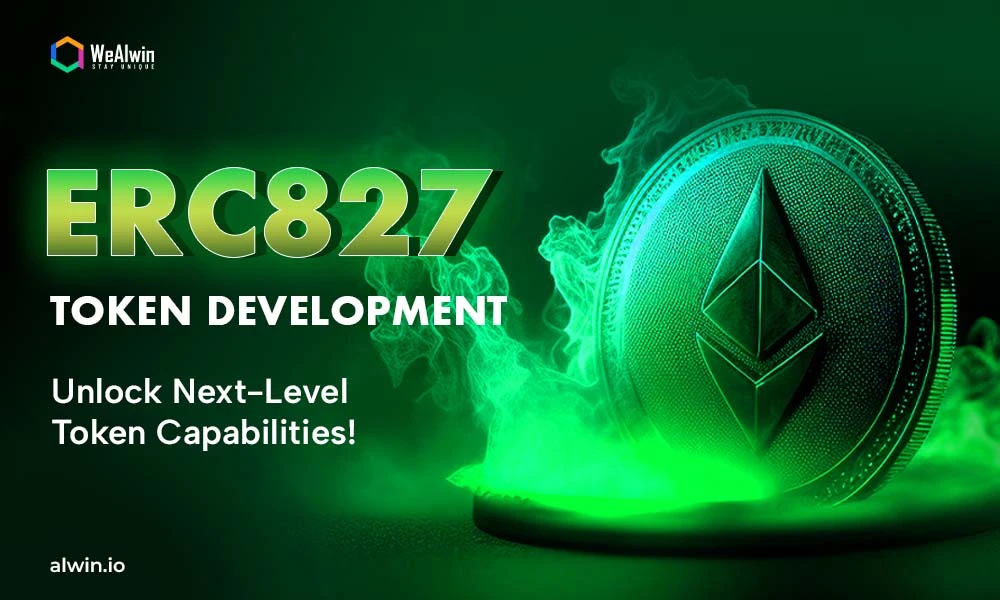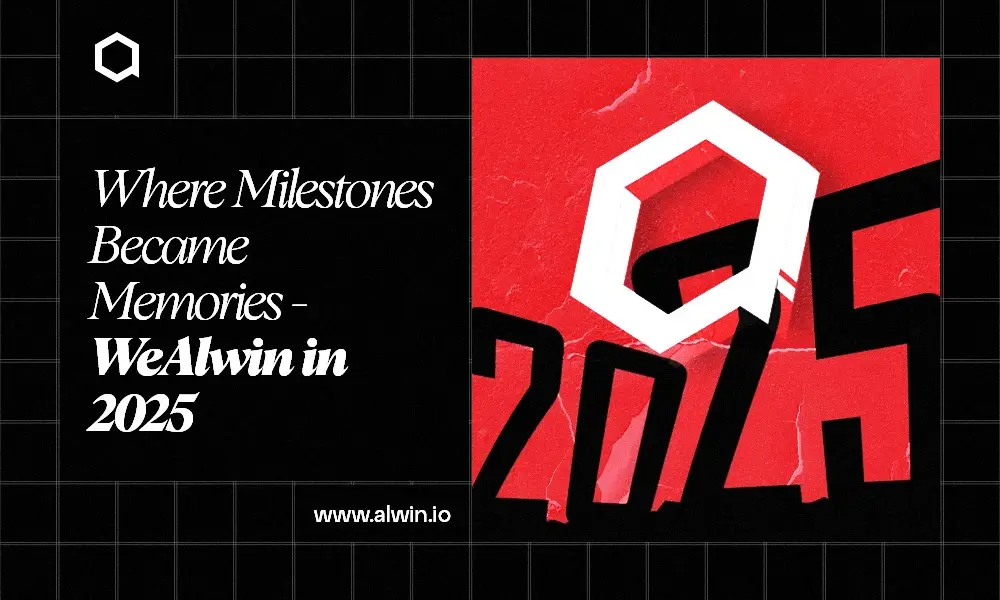"In the blockchain world, innovation is the key to unlocking potential." This sentiment rings especially true when it comes to token development. As businesses and developers strive to create more versatile and secure solutions, ERC827 token development emerges as a game-changing standard that enhances the functionality of traditional ERC20 tokens.
This blog will demystify the ERC827 token standard, exploring its key features and benefits while addressing common challenges faced during token creation. By understanding the advantages of ERC827, you’ll be better prepared to leverage this innovative standard for your projects, ensuring enhanced security, flexibility, and interoperability.
Let’s dive into how ERC827 can revolutionize your approach to token development.
ERC827 Token Standard
The ERC827 token standard, also known as the Ethereum token standard, is an extension of the popular ERC20 token standard. It was developed to enhance the functionality and capabilities of ERC20 tokens, providing a more advanced and flexible approach to creating tokens on the Ethereum blockchain.
ERC827 tokens build upon the foundation of ERC20 by introducing additional features and functionalities. The key difference between ERC827 and ERC20 is the ability of ERC827 tokens to carry out complex transactions and include additional data fields within the token transfer process. This enhanced functionality allows for greater customization and more advanced smart contract interactions.
To better understand the ERC827 token standard, it's essential to compare it with other Ethereum token standards:
- ERC20: The standard for fungible tokens on the Ethereum network. ERC20 tokens are interchangeable and have the same value as each other.
- ERC223: An improved version of ERC20 that aims to prevent token losses during transfers.
- ERC777: An advanced token standard that introduces features like hooks, which allow for more complex token transfer logic.
By understanding the key differences between these token standards, businesses, and developers can make informed decisions when choosing the most suitable standard for their ERC827 token creation projects.
Key Features of ERC827 Token Development
ERC827 token development introduces several key features that provide significant advantages for businesses looking to leverage blockchain technology.
1. Enhanced Functionality Over ERC-20 Tokens
While ERC20 tokens support basic transfer and approval functions, ERC827 allows for more sophisticated operations. This includes the ability to execute multiple actions within a single transaction, which can lead to reduced transaction costs and improved efficiency.
2. Support for Complex Transactions
One of the defining features of ERC827 tokens is their support for complex transactions. Unlike ERC20 tokens, which are limited to straightforward transfers, ERC827 tokens can incorporate additional data fields in their transactions. This capability enables to creation of more intricate workflows, such as multi-step processes that can be executed in a single transaction. This is especially valuable in decentralized finance (DeFi) applications, where multiple operations often need to occur simultaneously.
3. The "approveAndCall" Function for Streamlined Operations
The "approveAndCall" function is a standout feature of the ERC827 token standard. This function allows token holders to approve a specific amount of tokens for a smart contract while simultaneously triggering a function in that contract. By combining these actions into a single transaction, businesses can simplify their operations and enhance user experience.
Benefits of ERC827 Token Creation
As businesses explore the potential of blockchain technology, the creation of ERC827 tokens offers numerous advantages that can drive innovation and success.
Enhanced Security Measures in ERC827 Token Generation
Security is a paramount concern for businesses when it comes to blockchain-based solutions. ERC827 token creation prioritizes enhanced security measures to protect companies and their users. The ERC827 standard incorporates robust security features, such as advanced access controls and multi-signature requirements, ensuring that only authorized parties can execute token-related actions. This heightened security can instill confidence in businesses and their customers, fostering trust in the ERC827 token ecosystem.
Compatibility with Various Blockchain Networks
One of the key advantages of ERC827 token generation is the enhanced interoperability it offers. ERC827 tokens are designed to be compatible with various blockchain networks, allowing businesses to integrate their tokens across different platforms seamlessly. This interoperability enables companies to expand their reach, collaborate with partners, and create a more interconnected ecosystem.
Customizable Token Structures to Meet Business Needs
ERC827 token creation empowers companies with the ability to customize their token structures to meet their specific needs. From defining token supply and distribution to implementing unique token functionalities, businesses have the freedom to tailor their ERC827 tokens to align with their business objectives. This flexibility allows companies to create tokens that are tailored to their industry, target audience, and use case, ensuring a more targeted and effective implementation of blockchain technology.
ERC827 Token Development
ERC827 token development covers the development requirements, a step-by-step process for creating and deploying ERC827 tokens, and the importance of secure and efficient ERC827 token smart contract development.
Development Requirements: Tools and Programming Languages for ERC827 Token Creation
To develop ERC827 tokens, you'll need a solid understanding of Ethereum development and the tools and programming languages commonly used in the ecosystem. Some of the key requirements include:
- Solidity: The primary programming language for writing Ethereum smart contracts, which are the foundation of ERC827 tokens.
- Ethereum Development Tools: Such as Truffle, Ganache, and Remix, which facilitate the development, testing, and deployment of ERC827 tokens.
- Web3.js or Ethers.js: JavaScript libraries used for interacting with Ethereum nodes and deploying ERC827 token contracts.
Familiarity with these tools and languages is essential for successful ERC-827 token development.
Development Process: Step-by-Step Guide to Creating and Deploying ERC827 Tokens
The process of creating and deploying ERC827 tokens involves several key steps:
Defining Token Specifications: Determine the token's name, symbol, decimal places, and total supply.
Designing Token Functionality: Decide on the token's features, such as minting, burning, and pausability.
Writing the ERC-827 Token Smart Contract: Use Solidity to create the token's smart contract, following the ERC827 standard.
Testing and Debugging: Thoroughly test the token contract using tools like Remix and Truffle to ensure its functionality and security.
Deploying the Token: Use Ethereum development tools to deploy the ERC827 token contract to the Ethereum network.
Integrating the Token: Incorporate the deployed ERC827 token into your application or platform, enabling users to interact with it.
Smart Contract Development: Importance of Secure and Efficient ERC827 Token Smart Contracts
The success of an ERC827 token project heavily depends on the security and efficiency of its smart contract. The smart contract serves as the backbone of the token, defining its functionality and handling all token-related operations. To ensure the integrity of your ERC827 token, it's crucial to:
Follow best practices for Solidity programming to minimize vulnerabilities and bugs.
Implement robust access controls and authorization mechanisms to prevent unauthorized access to token functions.
Optimize gas usage to ensure efficient and cost-effective token transactions.
Conduct thorough testing and auditing to identify and address any potential security issues before deployment.
By adhering to these best practices, you can create secure and efficient ERC827 token smart contracts that provide a solid foundation for your blockchain-based applications and solutions.
Use Cases of ERC827 Tokens
ERC827 tokens offer versatile applications across various industries, providing businesses with innovative solutions to enhance their operations. Here are some real-world applications of ERC827 tokens:
Decentralized Finance (DeFi): ERC827 tokens can be utilized in DeFi platforms for lending, borrowing, and yield farming, allowing users to earn interest on their crypto assets while ensuring secure transactions.
Loyalty Programs: Businesses can implement ERC827 tokens in customer loyalty programs, enabling users to earn and redeem tokens for rewards, thus enhancing customer engagement and retention.
Supply Chain Management: ERC827 tokens can facilitate transparent tracking of goods throughout the supply chain, improving accountability and reducing fraud by providing verifiable transaction records.
Tokenized Assets: Companies can use ERC827 tokens to represent ownership of real-world assets, such as real estate or art, enabling fractional ownership and easier transfer of assets.
Crowdfunding and ICOs: Businesses can leverage ERC827 tokens for Initial Coin Offerings (ICOs) or token sales, allowing them to raise funds while providing investors with a stake in the project.
Common Technical Challenges and Solutions in ERC827 Token Implementation
While ERC827 token development offers numerous advantages, it also presents several challenges that businesses must navigate to ensure successful implementation.
1. Complexity of Implementation: The introduction of additional functions in the ERC827 standard, such as approveAndCall, transferAndCall, and transferFromAndCall, can complicate the development process. Developers must ensure that these functions are correctly implemented to avoid vulnerabilities.
2. Compatibility Issues: While ERC827 is designed to be compatible with ERC20 tokens, there may still be challenges when integrating with existing systems or contracts that are built on other standards, such as ERC223 or ERC777.
3. Token Loss Risks: One of the challenges with token transfers is the risk of tokens getting stuck in contracts that do not support the ERC827 standard. This issue can arise if the receiving contract does not handle the additional data parameter correctly.
Regulatory Considerations and Compliance Issues for ERC827 Token Issuance and Distribution
Legal Compliance: As with any token issuance, businesses must navigate the regulatory landscape to ensure compliance with local and international laws. This includes understanding whether the ERC827 token is classified as a security or utility token.
KYC and AML Requirements: Many jurisdictions require Know Your Customer (KYC) and Anti-Money Laundering (AML) procedures to be in place for token sales. This can complicate the ERC827 token distribution process.
Tax Implications: The issuance and trading of ERC827 tokens may have tax implications for businesses and users, depending on the jurisdiction. Understanding these implications is crucial for compliance and financial planning.
Future of ERC827 Token Development
The future of ERC827 token development is bright, with significant potential for growth and innovation.
Wider Adoption Across Industries: As more companies explore blockchain solutions, the adoption of ERC827 tokens is expected to expand beyond the cryptocurrency and DeFi sectors. Industries such as supply chain management, real estate, and entertainment are likely to implement ERC827 tokens for their unique functionalities.
Integration with Emerging Technologies: The integration of ERC827 tokens with emerging technologies, such as artificial intelligence (AI) and the Internet of Things (IoT), could lead to innovative applications. For example, ERC827 tokens could be used for automated transactions in smart contracts that interact with IoT devices.
Conclusion:
As we’ve explored, ERC827 token development is not just a technical upgrade; it’s a transformative opportunity for businesses ready to embrace the future of blockchain technology.
The potential applications are vast—from revolutionizing decentralized finance (DeFi) to enabling seamless supply chain management. Businesses that invest in ERC827 token development position themselves at the forefront of the digital economy, unlocking new revenue streams and enhancing operational efficiency.
Now is the perfect time to explore how ERC827 tokens can elevate your business. At WeAlwin Technologies, a leading Ethereum Token Development Company, we specialize in ERC827 token development, providing the expertise you need to succeed in this evolving landscape. Contact us today to discover how we can help you unlock the full potential of blockchain technology and drive your business forward!



